Wednesday, May 6, 2009
Dear Moderator...
I have tried to make my blog as easy to get around as possible, and so to help you find your way I have labelled all my research posts 'Research' and my planning blogs 'Planning'. Also my evaluation questions, as well as any extras that are linked with, or to do with my evaluation are under the label 'Evaluation'. You can also clip on any on the labels to see my initial ideas, or work through in chronological order starting in September to see my progress. You will also find my preliminary task which I worked on before starting the main task. This is labelled 'Preliminary Exercise Evaluation'.
On our group blog we have all our evidence of initial research and planning under the labels 'Research' and 'Planning' showing our inital thoughts and inspiration and our project developement, as well any other little posts that were conversation between the group. All posts that I was responsible for have been labelled with my name.
As you can probably see my group finished film opening sequence, and my preliminary sequence are at the top of my blog, and the group film can also be found at the top of our group blog.
Thank you for taking the time to look at my blog
Best Wishes
Amelia Conway-5220
Monday, February 2, 2009
I Declare this blog...
all done now
I've had a brilliant time working on this task, and working with Laura and Holly-thanks for being great group members
By blog, see you soon for our next task
xxxxxxxxxxxxxxxxx
Sunday, February 1, 2009
EVALUATION EXTRAS: Technology used...
Production
· Sony mini DV Camera
· Tripod
· Sound equipment
1. Boom microphone and pole
2. On camera Mics
3. Headphones
· Spots lights
· Clapper board
Post production
· Software
1. Premiere Pro
2. After Effects
3. i-movie
4. Soundtrack control
· Capturing
· Renderining
· Ghosting-layering two shots on top of one another
· Opacity-for the ghosting
· Titles (on the Mac)
· Timelines-5 different ones
· Transitions-fades, dissolves, cuts
· Razoring
· Contrast
· Brightness
· Saturation
· Sound-digetic and non-digetic
· Linking and unlinking
· Audio tracks
· Speed/duration
· Volume-adjusting volume and treble
· Re-ordering
· Parallel editing
· Importing clips
· Frames (zoom)
EVALUATION EXTRAS: Pre-Evaluation Summary
Opening sequence- It starts by seeing someone sign in to an acount-this person is called Julie. You then see someone typing in a dark room with a whisky glass beside them. They type things such as "oh you know i love talking to you". This is interspersed with titles on black backgrounds. Then action starts. A teenage girl looks upset and is talking to someone online. You can only see the hand of that person but you can assume it is a man. They continue to talk and the girl says about how she is suicidal and wants her life to end. The muderer, or 'Julie' comforts her and convinces Emma to invite him round. Then scene ends you finding out that there are infact two murderers, the other one is gathering equipment to kill the girl with.
The reset of the story continues with...
The muderers carry on in this same way luring girls by making them believe they are agony aunts and gain their trust. This is splashed all over the newspapers with a boost in teen suicides in London. One particular girl begins to talk to 'Julie' online to make herself feel better after her boyfriend broke up with her. However this girls father happens to be a detective working on the case of the teen suicides. The 'Julies' plot to kill this girl but she leaves clues that she knows her dad will find, to help save her or at least catch the muderers..but will it be too late? will they make it in time? and will the detective ever catch the agony aunts? Who knows..
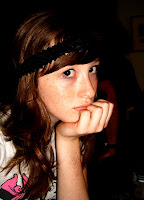
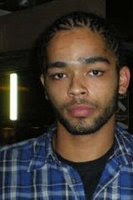

Directer/producer/editer/writer etc.-Holly, Amelia and Laura...
Saturday, January 31, 2009
Feedback of final film...
The main points which people commented positively on:
- The main actor-very realistic and scary
- the music at the opening
- the montage at the end
- the shot of the keyboard-very creative angle
- the seamless editing
- Titles look very realistic!! (this one was mentioned a lot)
Some things that people picked up on were:
- Could have shown the murderer later on for suspense, or not shown him at all
- lighting-too distinctly different
Other than that everyone has really liked and all of the people I asked said they would like to see the rest of the film. Also my younger brother said it was scary and he kept asking questions like 'what is he going to do..?' and I don't think he would want to watch the rest of the film BUT- this is a good thing as it shows we have targeted our audience well because we didn't aim to make a film aimed at younger children.
I am really impressed by the feedback and comments and I am really proud that the film I am showing them was created by myself and my friends.
Tuesday, January 27, 2009
Wednesday, January 21, 2009
Q7) Looking back at your preliminary task what do you feel you have learnt in the progression from it to the full product?
The Brief
Here are the two briefs to compare
Preliminary Task-Continuity task involving filming and editing a character opening a door, crossing a room sitting in front of another characters and exchanging a couple of lines of dialogue with them. This task should demonstrate match on action, shot/reverse shot and the 180-degree rule.
It also made us a lot more conscious of time; we needed to do things quickly, but not rush them. The preliminary task got us back into groups (which we hadn’t been in for over a year) and taught us how to share the shooting time equally giving everyone an opportunity. It also helped us to practice with our equipment before starting the main task. One of the most important things I learnt in the prelim for the production was to shoot much more footage than we needed, even if we weren’t going to edit it. This included taking more than one take of everything, and getting a wide range of angles and a master shot for most shots or lines of dialogue.
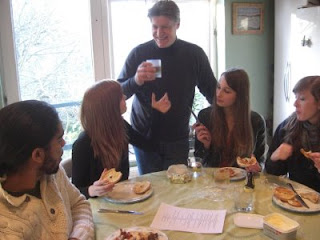
One thing we learnt which wasn’t about the actual process of filming, but about the filming day, was to give our actors breaks and asked their opinions on how they thought it was going to make sure they felt comfortable and involved.
Overall I found that the prelim was extremely useful for the real editing for our film brief. It reminded me how to use Premier Pro and gave me more confidence to stretch my abilities and experiment on other programs such as After Effects-when creating our production logo animation.
It was important to discuss things in our group and get audience feedback along the way: this was essential! Screening it a few times helped to get this. It reminded us to break down and encapsulate events whilst shooting i.e. problems, and blog them so that we could see where we went wrong and what things went well.
Overall I enjoyed the project so much. It gave me a brilliant insight into the world of cinematic media.
Q6) What have you learnt about technologies from the process of constructing this product?
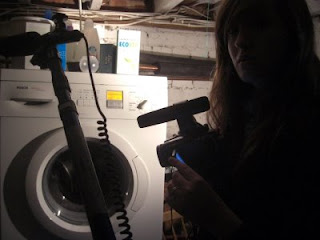 wise they end up looking disjointed and bumpy. I practiced a couple of times with a zoom into King (which was originally going to be our opening shot). Even though it didn’t make the final cut, it was still valuable practice in camera work and handling. Working on seperate timelines was new for this project. I have learnt how much easier it is as it allows you to have different types of shots on different timeslines to avoid them getting cluttered and confusing. It also means that you can practise something before putting it into the sequence.
wise they end up looking disjointed and bumpy. I practiced a couple of times with a zoom into King (which was originally going to be our opening shot). Even though it didn’t make the final cut, it was still valuable practice in camera work and handling. Working on seperate timelines was new for this project. I have learnt how much easier it is as it allows you to have different types of shots on different timeslines to avoid them getting cluttered and confusing. It also means that you can practise something before putting it into the sequence.I became familiar wit
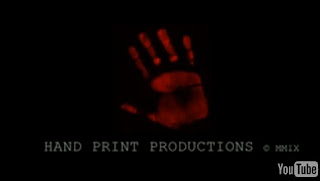 h iMovie, which we used to create our titles. Although never doing this alone, I now understand how the process works, and feel confident if left alone i could do it. I single-handedly learnt how to use After Effects, and created our production company logo. This really helped to stretch my skills on my own, rather than just the skills as a group. I aslso learnt more about sound and music when it comes to adding it onto the timelines. We used a copyright free track from http://www.freeplaymusic.com/ and our track was called 'A Cinematic Touch'
h iMovie, which we used to create our titles. Although never doing this alone, I now understand how the process works, and feel confident if left alone i could do it. I single-handedly learnt how to use After Effects, and created our production company logo. This really helped to stretch my skills on my own, rather than just the skills as a group. I aslso learnt more about sound and music when it comes to adding it onto the timelines. We used a copyright free track from http://www.freeplaymusic.com/ and our track was called 'A Cinematic Touch'We experienced some difficulties with our shots, such as the static camera sounds in the shots. We tried to overcome this by adjusting the treble. However this didn’t completely take away the sound but it worked to some extent. Another major problem we encountered was the auto-focus. We had never had to adjust the focus on the cameras before however during one of our shoots the shot started to go in and out of focus, so we had to adjust it ourselves. This was quite hard as we didn’t really know how to do it, but after some fiddling around we managed to get the shot in focus and looking good. It showed me how just to be patient and try things out. It also showed how important it is to know how your camera operates in case something like that was to happen again; that is one piece of advice I would definitely pass on! We experienced some health and safety issues when films. We were filming in a very small cellar, and there were 5 of us in on room. There were lots of wires and expensive equipment so we had to be very careful. It was essential that we were sensible because any of us could have tripped over a wire and broken something. We learnt to manoeuvre the equipment as a group and ask questions to check everything was ready before moving the tripod.
The saturation on most of King’s (murderers) shots was too green in contrast to the girl's shots so we had to adjust the colour balance on Premiere to warm up the shots. Another problem with technology was our camera kept going in and out of focus which meant it was extremely hard to get a good take.
As a whole I really stretched my abilities in this task and pushed myself. I was editing on my own a lot of the time which I enjoyed and I found that I could do it without the rest of my group.
Q5) How did you attract/address your audience?
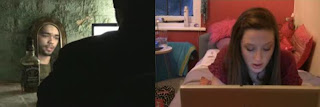 rderer. We also followed this theme through to production by using light (high Key) vs dark (low key) in the lighting to anchor the message of good vs evil. We also used common themes they would expect to see like ‘death’, or iconography such as a dirty room for the murderer, a young girl in a pink room. We had a particular murderer seeking death for a particular reason which is a convention of horror/thriller. We appealed to their pleasures by exploiting their fears. People go to see a horror filming because they expect to be scared, they expect to be confused and worried as to what will happen next. We used narrative twists such as at the very beginning the person signs in as ‘Julie’ and you then learn that person is a man, which confuses the audience. We also do no let on what the motives of the murderers are, which again keeps the audience guessing.
rderer. We also followed this theme through to production by using light (high Key) vs dark (low key) in the lighting to anchor the message of good vs evil. We also used common themes they would expect to see like ‘death’, or iconography such as a dirty room for the murderer, a young girl in a pink room. We had a particular murderer seeking death for a particular reason which is a convention of horror/thriller. We appealed to their pleasures by exploiting their fears. People go to see a horror filming because they expect to be scared, they expect to be confused and worried as to what will happen next. We used narrative twists such as at the very beginning the person signs in as ‘Julie’ and you then learn that person is a man, which confuses the audience. We also do no let on what the motives of the murderers are, which again keeps the audience guessing. 
We also appealed to them through our production and post-production (footage and editing). We used eye catching shots like the 'keyboard shots' which not only look effective but create a sense of danger as you cannot see the persons face. We used clever editing also to create enigmas, such as the use of sound bridging. We used the sound of the printer of a shot of the victims face when really it was the murderers printing the victims address. This was a technique to, firstly, confuse the audiences as well as make them more engaged by showing the man picking up the paper afterwards, which makes them think “oh, they’re printing it! I see now, very clever”. Our audience are intelligent and like to be challenged when watching a film. They will have chosen this film because it is a thriller and doesn’t give everything away immediately, so by leaving things out and creating enigmas, we are actually appealing directly to our audiences tastes.
We had to change a few things to attract out audience more, such as adding in a drone to create a more threatening scene. This also made it more traditional.
Our audience feedback shows that we did in fact attract them as nearly all of them said they would like to see the rest of the film because of its music and interesting camera angles.
However some people did say that the contrast in lighting between the girls what’s and the boys shots. If we were to do it again we would like to have had better lighting equipment. Another piece of feedback we got was that we should have delayed showing the murderers face to create a greater enigma. I also agree with, we perhaps tried to put across too much information in the first two minutes.
Q4) Who would be the audience for your media product and why?
Age- We decided that because our film is quite serious, with adult themes we made our film certificate 15. Our core audience is mostly students ages 18-25
Our secondary, wider audience is people ages 16-40 as we believe anyone who enjoys the horror/thriller genre will enjoy our film. Younger children would not enjoy our film as it has themes of death and rape; this is why elderly people may not like it either.
Gender- Our film is not gender specific in its audience
Nationality- Our film will be most enjoyed by British as they can relate to the film.
Lifestyle- The people who will want to watch our film are well educated, and will enjoy the complexities and enigmas of our plots. This is why we are targeting students as our audience. They are young and insightful and will enjoy our quirky camera style, as well as the plot about the internet. Their tastes in media will be similar to that of our film-films that keep you on the edge of your seat. We appeal to the audience expectations; they expect to be scared, to jump and to have to try and piece together the storyline.
Q3) What kind of media institution might distribute your product and why?
The type of media institution distributing your media product depends largely on what type of film you are creating. If you have created a large Hollywood block buster that you want to be seen worldwide, you would show it in the main cinemas like ‘Odeon and Vue’ in the UK to appeal to the widest audience possible to gross a greater profit. However if you had created an independent film, it is limited in where you can show it due to budget and sometimes due to the content of the film. It would usually be shown in small independent cinemas, old cinemas or arty places and at exhibitions, or special independent film screenings at cinemas such as the Rio, or The Phoenix in North London. Often you can also watch them via the internet. If our film was made as a low-budget film (which it was) it would be shown at film festivals, such as the largest one, in Manchester, or on the Independent Film Channel. Most student films are put online and can gain a large audience through the web. For a student film such as ours I believe this would be the best way to target a wider audience.
Although ours is only a student film, in the real media world if our film was made without being on a student budget, I believe ours would be played in the main cinemas in bigger towns, as well as a selective few smaller cinemas for limited time in smaller towns. This is because I believe of piece has quiet a significant message about using the internet, and about how crucial the internet is in our lives and yet it is so potentially dangerous. We are therefore raising awareness through our film, which is why the film should be shown nationwide. By showing it in the main cinemas it would bring in a wider audience and gross more.
Film4 (a well known film channel/distributer/production company), in 2007, began sponsoring an annual ‘FrightFest’ which started in 2000. It is a 4 day film festival that has premiered such films like ‘Scary Movie 1 & 2’, ‘Donnie Darko’ and ‘Jeepers Creepers’. It also has sponsors such as Channel 5 and Horror Channel. In 2005 the ‘FrightFest’ moved to the Odeon Cinema in the West End giving it a wider audience appeal. They also hold events called ‘Fright Fest Presents’ at universities such as Cambridge, Brighton and Glasgow; which targets our primary audience perfectly as well as distributing our audience to a large audience at one time. Here's the website-http://www.frightfest.co.uk/
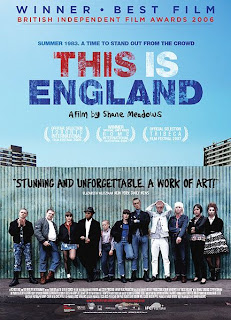
Film4 are a film producing company who have produced award winning British films such as ‘This is England’ (Shane Meadows,2006). I believe Film4 would commission to distribute our film because it is a British film that portrays an important message and will be popular among a young audience.
Q2) How does your media product represent partucular social groups?
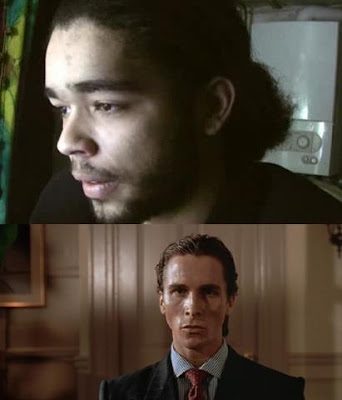 The other murderer was also tall and dressed all in black to look menacing. He is wearing a beanie which fits in with the more ‘classic’ thug/murderer appearance. He was putting knifes and other equipment into a briefcase, showing he is the more violent one and that the one on the computer is more charming.
The other murderer was also tall and dressed all in black to look menacing. He is wearing a beanie which fits in with the more ‘classic’ thug/murderer appearance. He was putting knifes and other equipment into a briefcase, showing he is the more violent one and that the one on the computer is more charming.We used a young girl who looked innocent and lived in a fairly middle class house. She looks innocent by the makeup and clothes she is wearing. Her makeup is minimal, not vulgar or garish, and her clothes are not revealing, she is wearing a knitted top (in pink) and jeans. We can see she is in a middle class house because she has a mobile phone on her bed which also has lots of pillows and looks quite lush. She had her own laptop showing she must be fairly affluent. She had a pink room showing she is girly.
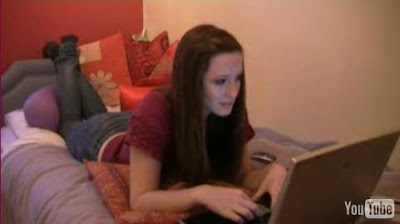
When thinking about how to represent age when had to think about the actors ages. Since our audience is young adults ages between 18-25, we decided to use actors in that age range. Emma’s character would not have worked if she were older, because to seem more helpless she had to be younger.
We were also representing certain states of mind in our film. Obviously our film has a theme of suicide which needs to be approached delicately as it is a very serious matter. Films that have done this well include ‘The Virgin Suicides’ (Sofia Coppola, 1999). The suicidal girls are exploited in our film, due to their vulnerable state. Another state of mind we represent is mental illness. Perhaps not overtly apparent, but clearly the murderer has some mental issues to be murdering young girls. The way we represented this was by making the murderer seem clever and cunning, and yet sick and twisted, which are shown by his facial expressions and lines such as “yeah that comes later darling”.
Q1) In what ways does your media product use, develop or challenge forms and conventions of real media products?
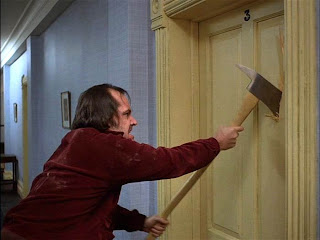 eparating them. Then there was drama; using fast paced editing and lots of action to keep the audience enticed. Then we began to look at horror and thriller and as we did this we focussed deeper and deeper in on it, realising this is probably what we would want to choose for our own genre. And we did. The horror/thriller crossover share many common conventions such as a dark environment (often) with a main murderer, and a main victim (or possible victim). Some of the common themes of horror are death, victims, as well as the conventions of the production such as ominous music, and editing or creating a story which itself creates and enigma for the audience: leaving them guessing. Two examples of this are Hitchcock’s ‘Psycho’ (1960) as well as ‘The Shining’ (Kubrick, 1980) as well as many others. Both films holdback information until the end so the audience are more intrigued and, ultimately, more scared. We generally fit to these conventions of the horror thriller genre by having the classic characters of a ‘victim girl’ and a ‘nasty
eparating them. Then there was drama; using fast paced editing and lots of action to keep the audience enticed. Then we began to look at horror and thriller and as we did this we focussed deeper and deeper in on it, realising this is probably what we would want to choose for our own genre. And we did. The horror/thriller crossover share many common conventions such as a dark environment (often) with a main murderer, and a main victim (or possible victim). Some of the common themes of horror are death, victims, as well as the conventions of the production such as ominous music, and editing or creating a story which itself creates and enigma for the audience: leaving them guessing. Two examples of this are Hitchcock’s ‘Psycho’ (1960) as well as ‘The Shining’ (Kubrick, 1980) as well as many others. Both films holdback information until the end so the audience are more intrigued and, ultimately, more scared. We generally fit to these conventions of the horror thriller genre by having the classic characters of a ‘victim girl’ and a ‘nasty 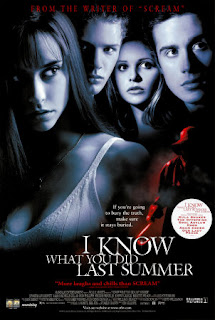 murderer’, as well as using enigmas, by not showing the murderers face until the third thing he says, and having him sign in at the very beginning as ‘Julie’ making audiences believe him to be a woman. We used iconography similar to that of other horror films. These included the location; a dirty cellar and the lighting; low key and shadowy. Another way we represented the genre of a horror/thriller is that we used the theme of stalking, which has been used is film such as ‘I Know What You Did Last Summer’ (Gillespie, 1997). We also used chilling music such as an ominous drone. In our audience feedback it showed that they all thought it was horror/thriller, so it shows that sticking to the conventions works well.
murderer’, as well as using enigmas, by not showing the murderers face until the third thing he says, and having him sign in at the very beginning as ‘Julie’ making audiences believe him to be a woman. We used iconography similar to that of other horror films. These included the location; a dirty cellar and the lighting; low key and shadowy. Another way we represented the genre of a horror/thriller is that we used the theme of stalking, which has been used is film such as ‘I Know What You Did Last Summer’ (Gillespie, 1997). We also used chilling music such as an ominous drone. In our audience feedback it showed that they all thought it was horror/thriller, so it shows that sticking to the conventions works well.However to be more creative we didn’t stick rigidly to conventions, for example, we used a modern but still twisted storyline, involving the internet, and we also had two murderers which is uncommon in most horror films. We also used a modern piece of music which sounded like a dial-up internet connection to continue our particular theme. We stuck to most of the old forms and conventions of horror with modern twists to it, such as its modern context of meeting people over the internet. We didn’t choose to stick to Todorov’s classic narrative pattern of staring with an equilibrium, with a disruption that eventually gets resolved, because we felt it made more of an impact on the audience to start with disruption.
We also had to look at the conventions of an opening sequence in order to create a film that was accurate in content and in its production
Conventions include:
- Introduction to key characters (Elle in Legally Blonde, Luketic 2001)
- Titles throughout
- Music (Shining)
- Info on what is to come (Magdalene Sisters, Peter Mullen 2004)
- Main themes of the film (killers obsessive record keeping in Seven, Fincher 1995)
- Visual references to the title (pumpkins in Halloween, Carpernter 1978)
- Sense of danger from the offset-only for horror (Seven starts with a dead body)
- Symbolic/iconic images
We stuck to all these conventions I believe as we introduced our murderers (the girl was merely the first victim), we had titles throughout and music, introduced the main theme of the internet and gave an insight into what was to come. We have used many narra tive techniques in our sequence such as editing it in real time, using cross-cutting, and a small ellipsis between bits in the conversation. Some of our action and enigmas codes include our montage sequence at the end, and the enigma is when you can hear the printer sound but are unsure as to who is printing it. We used the classic characters roles from horror films such as the victim, insignificant to the overall plot but just one to add to the body count. In our film she is a girl like most horror films including ‘Scream’ (Craven 1996). The overall style of our piece is very eerie, with close-up camera work to show the expressions of both murderer and victims face, be it scared or smug. Our sequence has continuity such as match-on-action and shot reverse shot, however breaks this by having a montage at the end.
tive techniques in our sequence such as editing it in real time, using cross-cutting, and a small ellipsis between bits in the conversation. Some of our action and enigmas codes include our montage sequence at the end, and the enigma is when you can hear the printer sound but are unsure as to who is printing it. We used the classic characters roles from horror films such as the victim, insignificant to the overall plot but just one to add to the body count. In our film she is a girl like most horror films including ‘Scream’ (Craven 1996). The overall style of our piece is very eerie, with close-up camera work to show the expressions of both murderer and victims face, be it scared or smug. Our sequence has continuity such as match-on-action and shot reverse shot, however breaks this by having a montage at the end.
Wednesday, January 14, 2009
Test Screen
we got lots of positive feedback which was good but also people suggested things to change.
- turn down treble on master shot of me
- cut music down at end-too distracting
- quiet down sound of keys
- needs a change of music as montage starts-change of music for change of pace-also too distracting..
- drone too loud
- printer quieter
All of these are easily sorted out and we will change them tomorrow. After that we will be done!!
Tuesday, January 6, 2009
Sorry it's been so long...
I plan on filling you in on what has been happening during our production
Sorry that it's taken me this long...but i'm back
x




